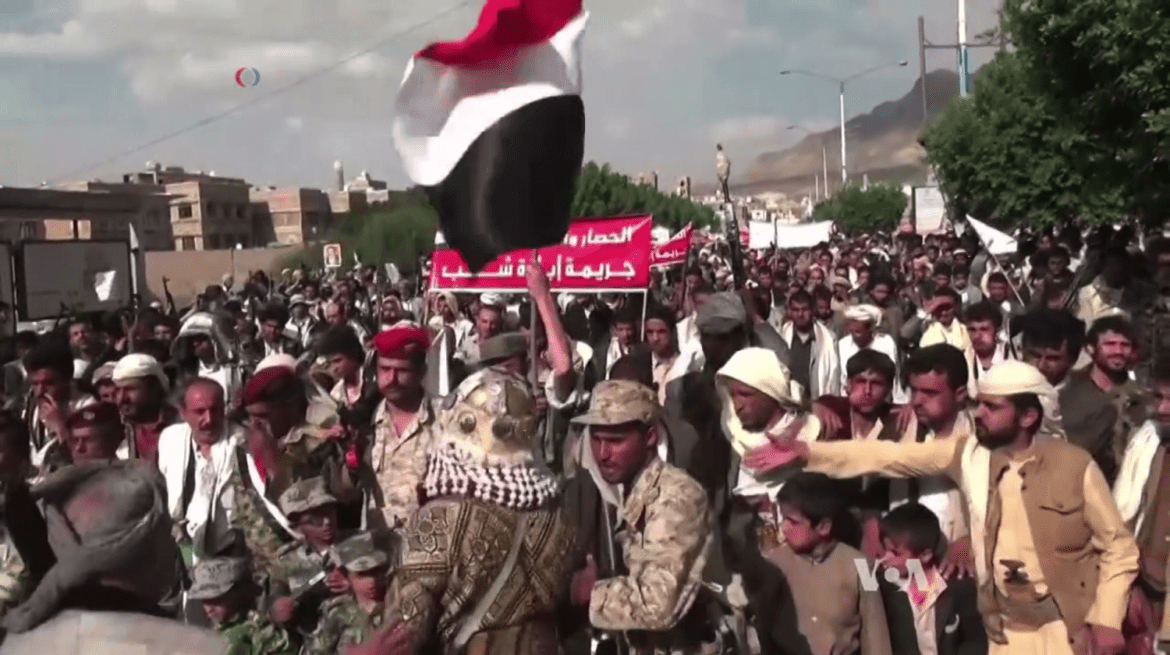The Houthi arsenal is extensive, and it is now being activated against Israel.
Yaakov Lappin
(JNS)
In its first operational use against a surface-to-surface ballistic missile, Israel’s Arrow 2 successfully intercepted the threat, fired from Yemen at the Red Sea city of Eilat in the far south of the country, on Tuesday. Another interception of aerial threats from Yemen occurred hours later.
The Houthis in Yemen have been firing missiles and UAVs at southern Israel on a regular basis, upping the pace since the ground offensive in Gaza began last Friday. All threats from Yemen have so far been intercepted safely, and the Israel Defense Force expanded the presence of the Israel Navy in the arena as well.
Israel Aerospace Industries, which produces the Arrow system, designed to intercept ballistic missiles outside of Earth’s atmosphere, works with the Defense Ministry to develop the interceptors.
The Arrow missile defense system is a critical component of Israel’s multi-layered defense system, and made its operational debut in 2017, when it intercepted a stray anti-aircraft missile from Syria. But the Houthis have many more weapons in their extensive arsenal.
According to Col. (res.) Shaul Shay, Director of Research, Institute for Policy and Strategy at Reichman University, and former deputy head of the National Security Council of Israel, the Houthis have a large arsenal of ballistic missiles, cruise missiles, and UAVs with a range sufficient to hit the south of the country.
“The missiles and UAVs are of original Iranian manufacture, but they [the Houthis] are already producing some of them in Yemen,” Shay told JNS.
“The Houthis have rich operational experience in using these tools against Saudi Arabia and the United Arab Emirates, against whom they have been fighting since 2015. It is important to add that the threat from the Houthis is also against Israeli vessels in the Bab al-Mandab area and the coasts of Yemen. The Houthis have already declared this publicly,” he stated.
Shaul noted that the Houthis in Yemen consider both the U.S. and Israel as enemies and the slogan of the Houthi movement is “Death to America, Death to Israel, Curse on the Jews, Victory to Islam.” The leader of Yemen’s Houthi rebels has repeatedly warned that they will join wars of Hezbollah and Palestinian terror groups against Israel.
Iran-backed Houthis in Yemen have now joined the war against Israel and has opened a new front, Shay pointed out.
On Oct.19, the Houthis fired cruise missiles and drones in a northerly direction—toward Israel—that the USS Carney destroyer in the Red Sea, and, reportedly, Saudi air defenses, intercepted. On Oct. 22, the Houthi army claimed responsibility for that attack.
The interceptions came as military bases hosting U.S. forces in Iraq and Syria came under a spate of UAV attacks.
On Oct. 27, blasts hit Nuweiba and Taba in Egypt’s southern Sinai to the southwest of Israel. The Houthis did not officially comment on the incident, but UAVs fired from Yemen are likely to have been behind that blast, according to Shay.
Egypt’s military army spokesperson, Gharib Abdel-Hafez, said in a statement that “two drones were coming from south of the Red Sea to the north.”
“The Houthi threat against Israel appears to be increasing and with Iran’s continued support for the Houthis the Red Sea could potentially become another area of conflict in Iran’s proxy war against Israel,” said Shay. “The Taba and Nuweiba explosions highlight the risks facing not only Israel but Egypt and other countries in the region,” he cautioned.
“Iran’s coordination with its regional proxies since Hamas’s attack on Israel on Oct. 7 strongly suggests that the proxies are acting as part of an Iranian-organized strategic plan. Iran has denied involvement in planning the attack, but the country’s Supreme Leader Ayatollah Ali Khamenei praised the slaughter in a televised address,” Shay noted.
On Sept. 21, the Houthi army held a military parade in Yemen and the Alma Center, an Israeli defense research group, identified several key weapons systems displayed.
The armaments included F-5 fighter jets, naval vessels, anti-ship mines, anti-ship missiles of ranges of between 200 to 350 kilometers, radar systems, surface-to-air missiles, UAVs with ranges of up to 2,000 kilometers, cruise missiles with ranges of between 700 to 1,400 kilometers, ballistic missiles with ranges of between 300 to 800 kilometers, and more.
The Houthis are also believed to possess Shahab 3-derived long-range ballistic missiles, with a range of some 2,000 kilometers, and Quds 3 cruise missiles, derived from the Iranian Soumar, which could also strike Israel.
Image: Iranian-backed Houthis in Yemen. Credit: Wikimedia Commons.


